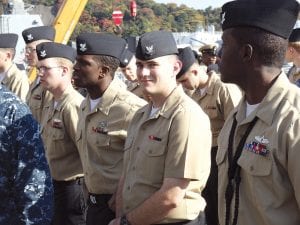Evan Smith knew he would be traveling when he joined the Navy. But he probably didn’t imagine that he would end up at the scene of one of the largest natural disasters in recent history. On March 11, 2011, U.S. Navy Fire Controlman 2nd class Smith was aboard the USS Shiloh in the ship’s homeport, Yokosuka, when the 9.0 earthquake hit Japan.
Evan is the son of Tom and Cathy Smith of Red Wing, MN and the grandson of Nona Smith of Grand Marais.
Smith joined the Navy in October 2008 and went to boot camp at Naval Station Great Lakes in Illinois, followed by fire Controlman “A” school. He chose to go to further training on the Tomahawk weapon system and attended “C” school in San Diego, California.
He is presently assigned to the USS Shiloh, a Ticonderoga class guided missile cruiser, where he was enjoying a tour of duty in Japan. He had even learned “a little” Japanese. “I know enough to be polite when I leave base,” he said.
However, off-duty trips ashore are quite different now. The News-Herald was able to reach Smith last week by e-mail and asked where he was when the earthquake struck—and if there was any warning.
Smith said the ship did not receive warning. He was on the aft missile deck working on preservation— removing rust and repainting metal surfaces corroded by the sea environment. The first thing he noticed was the ship listing to port “noticeably.”
“I was sitting down when it happened and I saw that the vehicles on the pier, including the mobile cranes were shaking. I heard the mooring lines straining and one of them actually parted—all I heard was a snapping sound.
“The Shiloh is somewhere around 650 feet long, so we did not have any damage,” Smith said.
He added that the ship was moored in a sheltered harbor so the tsunami did not reach them at first. When it did, he said, “The ship really did rock!”
Because of the frayed mooring line, port operations sent pusher boats to the ship to take strain off the lines so it could be replaced.
Smith’s homeport is in southern Japan, not near the nuclear disaster at the Fukushima nuclear energy plant. However, the Shiloh left homeport and was stationed off the northern coast of Japan for about a month, as a base for helicopters flying in supplies. The ship stayed off shore because of the radiation concerns.
But even from afar, Smith said he could see the devastation. “We were well away from land, but we could see debris from shore floating in the water,” he said.
Seeing video of devastation, it seems an impossible task to cleanup and rebuild. The News- Herald asked Smith for his thoughts on how the Japanese people are handling this. He replied, “The Japanese are handling the situation well. Power is mostly restored and the roads are passable. Cleaning up will take time though.”
Smith is now back in his homeport of Yokosuka. He said, “Everyone on board wanted to help the Japanese people as soon as possible. The Navy called it Operation Tomodachi, which means friend. I am proud to have been able to help Japan.”



Loading Comments